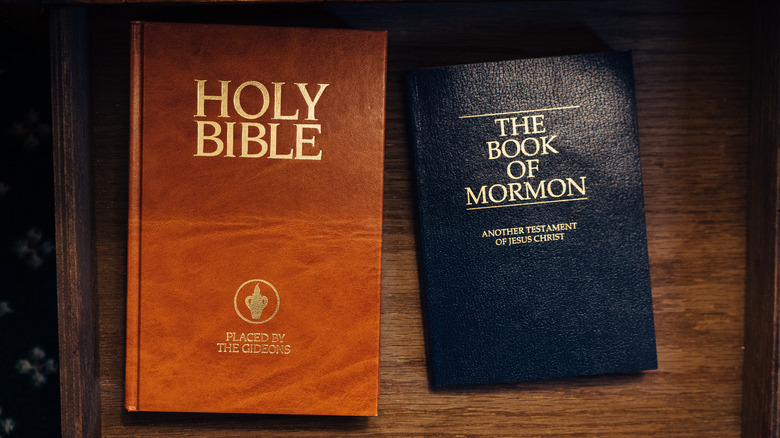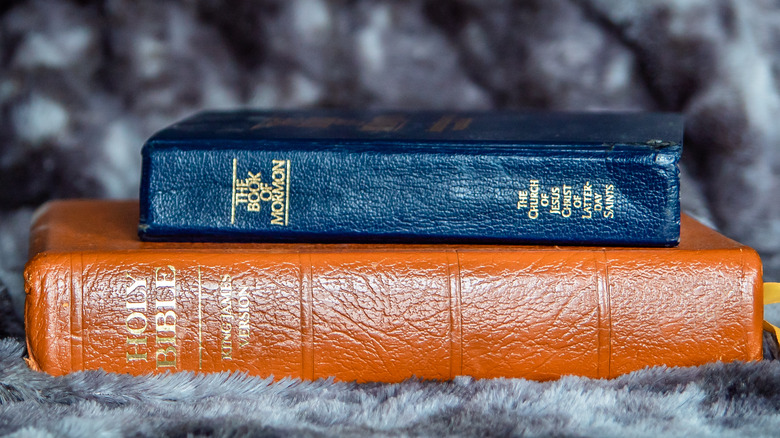Is The Book Of Mormon The Same As The Bible?
For the world's Christians and Jews, the Bible is their sacred text. However, for a comparatively small subset of Christians, there's a second, companion book, "The Book of Mormon." You may have even seen commercials (posted on YouTube) in which the viewer was given a toll-free number to call for a free copy of the book, which is subtitled, "Another Testament of Jesus Christ."
Since both books are used by people who identify as Christians, and since both books involve the story of Jesus Christ (Jesus' role in the Bible is confined only to the much-smaller New Testament), some may wonder if the two are actually just different versions of the same book.
In fact, the two books are entirely different in a number of ways, including their origins, their scope, the messages contained within their texts, their translations, the attitudes that the two religions have about the two books, and more.
The Bible and the Book of Mormon have different origins and scope
The Bible was written (or compiled, depending on your point of view) over the course of centuries, by several different men, and covers a period of history from hundreds of years before the birth of Jesus Christ until about a century or so after his death. The Bible isn't actually one book; it's more like a library of different kinds of writing, including history, poetry, law, and prophecy. The entirety of the book takes place in the region around the Mediterranean Sea. By comparison, according to Britannica, the Book of Mormon purports to tell the story of a group of Hebrews who immigrated to the New World and what happened to them afterwards, including a visit by Jesus Christ long after his resurrection.
The Bible and the Book of Mormon have completely different origins. The former was the result of centuries of editing and compilation. The Protestant Bible contains 66 books; the Catholic, 73. The Book of Mormon, on the other hand, was purportedly written down on gold plates by a prophet and his son, hidden in upstate New York, and then revealed to the prophet Joseph Smith in 1823, who published his English translation of the text in 1830.
Mormons and the Bible, and other Christians and the Book of Mormon
In addition to the key differences between the books themselves, there are major theological differences in how the Church of Jesus Christ of Latter-day Saints looks at the Bible and the Book of Mormon, and how the rest of Christendom looks at the two books.
For Christians who do not belong to the Church of Jesus Christ of Latter-day Saints (they prefer to not be called Mormons), the King James version of the Bible is the inspired word of God, with different doctrinal traditions holding differing views on just how inerrant it is and how literally it is to be taken, as Missio Alliance explains. That it's necessary to translate it into English, and that translation is an inexact science that may get some things wrong, is considered a necessary evil. The Latter-day Saints, however, believe that the Bible is true only insofar as it's translated accurately, but that on the whole, it's translated inaccurately, according to BBC News.
Most of Christendom that does not affiliate with the Latter-day Saints Church rejects the idea that the Book of Mormon is true or inspired, as author Solveig Nilson wrote for Luther College. The Latter-day Saints, on the other hand, not only believe that their text is true and comes directly from God, but that, unlike the Bible, its translation into English is accurate and error-free.
How the Book of Mormon has led to scandal
The story of how the Book of Mormon was written has both raised the eyebrows of the skeptical and allowed for fraudsters to take advantage of the Church of Latter-day Saints. Since Joseph Smith dictated the supposed sacred text he'd found on golden tablets to Oliver Cowdery, the entire foundation of the religion relies on trust in Smith to have been telling the truth. But trust can be taken advantage of, and that's exactly what happened in the 1980s, when the scandal of the Salamander Letter rocked the LDS Church. According to the L.A. Times, a purported dealer of religious documents named Mark Hofmann turned out to have been defrauding the church, receiving large payments for documents that he claimed to have authenticated as contemporary with the writing of the Book of Mormon.
One such document was the Salamander Letter, in which claimed that Smith had found a white salamander along with the sacred texts. The animal morphed into a spirit and, for some reason, told Smith to exhume the body of his brother. Some in the church denounced the letter for the air of magic and fantasy it lent the religion, but others dug the salamander story and added it to their list of official historical texts. When church officials caught wind of what Hofmann was doing, he built bombs and killed two people before one accidentally exploded in his car with him still in it. He didn't die, but neither did things turn out too well for the fraudster.



